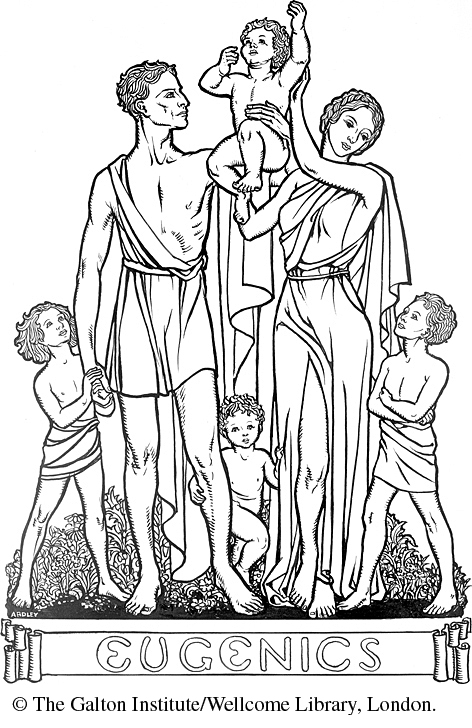1. The Idealized Family
Printed Page 205
Eugenics Education Society of London, Eugenics for Citizens: Aim of Eugenics (c. 1907)
As Europe’s falling birthrate sparked concerns that Anglo-Saxons were committing “race suicide” by not having enough children, marriage and sexuality came under the public spotlight. Social Darwinists were especially vocal in their warnings of racial decay. Among the most famous of these was Charles Darwin’s cousin Sir Francis Galton (1822–1911), who reasoned that society’s efforts to protect the weakest, most vulnerable members of humanity were in fact at odds with natural selection—meaning that far from evolving to become a stronger and more talented people, society risked reverting toward mediocrity, or experiencing a “regression toward the mean.” Galton created the term eugenics, defining it as “the study of the Agencies under social control, that improve or impair the racial qualities of future generations either physically or mentally.” In 1907, friends of Galton’s from Cambridge joined with middle-class professional men interested in eugenics to form the Eugenics Education Society, electing Galton as their first president. Their aim was practical rather than scholarly: to spread the wisdom of eugenics as widely as possible in society, with the aim of improving the population as a whole. With this goal in mind, the society published pamphlets, such as the one from which the image below was taken, to explain eugenic concepts simply enough for all people to understand.
From www.uvm.edu/~eugenics/images/citizens.html. © Galton Institute Archive/Wellcome Library.

DISCUSSION QUESTIONS
- How does the family in the pamphlet illustration demonstrate the Eugenics Education Society’s vision of the ideal man? The ideal woman? The ideal family?
Question
How does the family in the pamphlet illustration demonstrate the Eugenics Education Society’s vision of the ideal man? The ideal woman? The ideal family?
accept_blank_answers: true
points: 10How does the family in the pamphlet illustration demonstrate the Eugenics Education Society’s vision of the ideal man? The ideal woman? The ideal family? - Why do you think the illustrator chose to show a family in classical attire rather than in turn-of-the-century clothing?
Question
Why do you think the illustrator chose to show a family in classical attire rather than in turn-of-the-century clothing?
accept_blank_answers: true
points: 10Why do you think the illustrator chose to show a family in classical attire rather than in turn-of-the-century clothing? - What parallels can be drawn between the turn-of-the-century interest in eugenics and present-day curiosity about the possibilities of genetic engineering?
Question
What parallels can be drawn between the turn-of-the-century interest in eugenics and present-day curiosity about the possibilities of genetic engineering?
accept_blank_answers: true
points: 10What parallels can be drawn between the turn-of-the-century interest in eugenics and present-day curiosity about the possibilities of genetic engineering? - Sir Francis Galton once wrote that eugenics “must be introduced into the national consciousness as a new religion.” How might this image inspire religious sentiments?
Question
Sir Francis Galton once wrote that eugenics “must be introduced into the national consciousness as a new religion.” How might this image inspire religious sentiments?
accept_blank_answers: true
points: 10Sir Francis Galton once wrote that eugenics “must be introduced into the national consciousness as a new religion.” How might this image inspire religious sentiments?